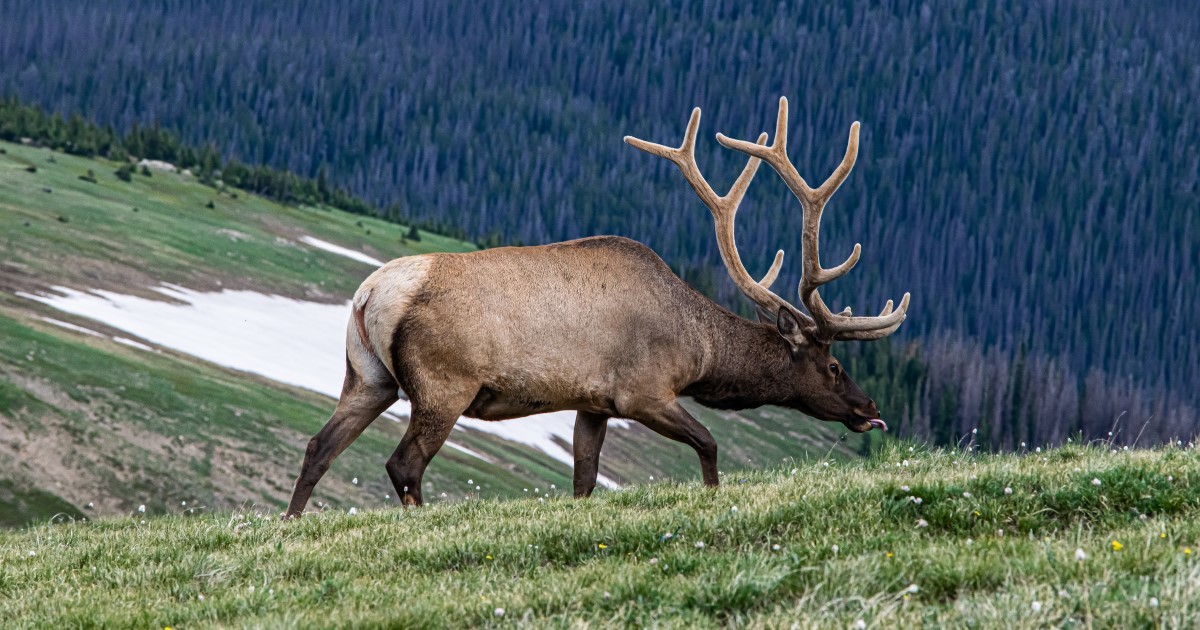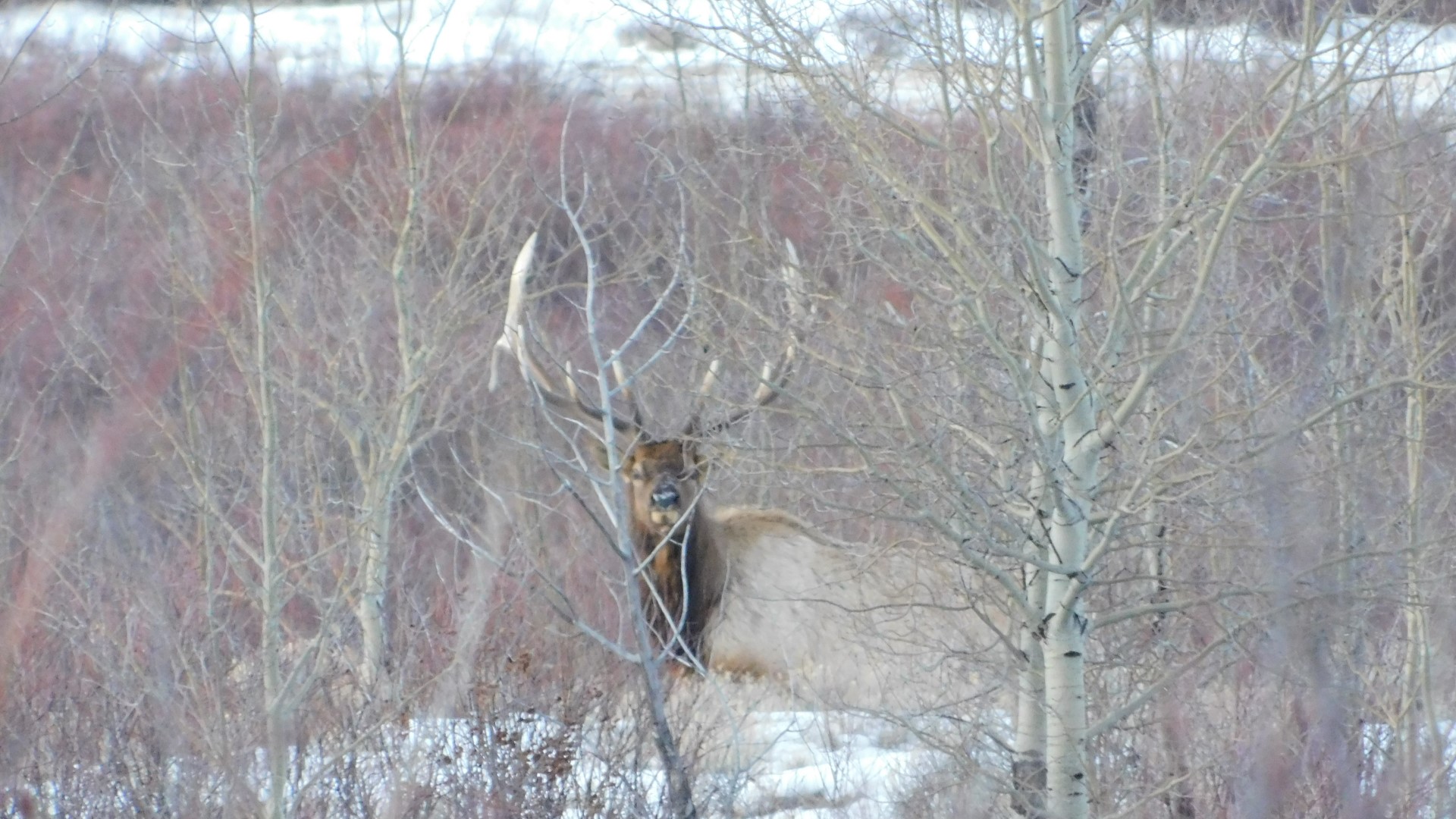As an Amazon Associate, Alpha and Omega Outdoors may earn from qualifying purchases.
Why should you be worried about learning about E-scouting for elk with Google Earth? The simple answer is – to find more elk during your elk hunting trip. For many of us, it is extremely hard to find the time to get boots on the ground to scout hunting areas for elk. This is especially true for all of you nonresident elk hunters out there. In addition, spending two or three of your precious hunting days can be a waste of time. Time you could use to be actually hunting.
Table of Contents
- E-Scouting for Elk With Google Earth Is Your Answer
- How Can Google Earth Help You
- E-Scouting for Elk Can Help You Close In On Your New Elk Hunting Location
- Example: A New Area To Check Out When Done E-Scouting For Elk With Google Earth
E-Scouting for Elk With Google Earth Is Your Answer
E-Scouting for Elk is a way to scout from the comfort of your home well ahead of the start of the hunting season. That way, when the season finally begins, you’re prepared to get out and hunt much quicker. With the help of Google Earth’s free technology you can now scout for elk from your computer.
How Can Google Earth Help You
Google Earth is a popular and free program that every hunter should be using. Google Earth allows you to explore any area where there are elk, in 3D, using satellite imagery.
- With this ability to use the satellite imagery, you can start looking for and identifying the best elk spots.
- There are many tools that come bundled in the software that will be helpful for locating and marking watering, bedding, and feeding areas used by elk.
- You will then be able to upload or copy the GPS coordinates for the areas you found on Google Earth to a hand-held GPS unit.
- If you are not a GPS person, you can print maps.
How To Mark Locations On Google Earth
Marking your locations is fairly simple once you understand how to get it done.
- To add a marked location, you need to click “Add Placemark” and move the waypoint to that spot on the map.
- Change the name of the mark to something that is clear and makes it easy to know what the mark points to. Examples of names are “Water”, “Food”, and “Cover”. Giving the marks numbers after the name is optional but it helps to make the waypoints easier to read.
- Another helpful hint is to lay out your expected route to an area and save it on Google Earth. You will be able to upload this to your GPS. This will be really helpful getting to your spot in the dark.
Example: How To Add A Placemark On A Water Hole


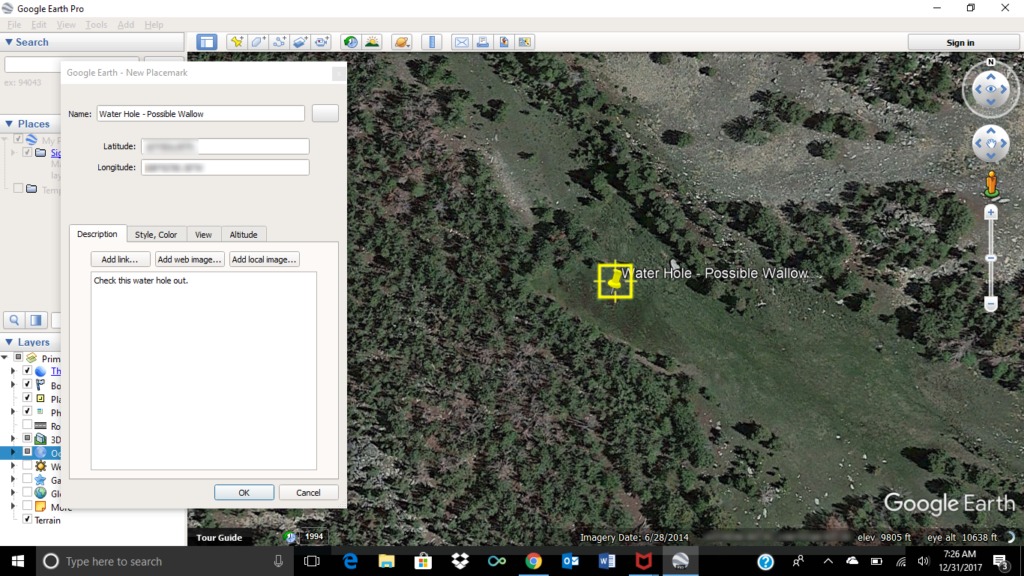
E-Scouting for Elk Can Help You Close In On Your New Elk Hunting Location
Going on elk hunt can be one of the best experiences any hunter can have. Provided of course you know where to look for them. Using Google Earth for E-Scouting for Elk will allow you to take a whole unit, which could be hundreds of square miles, and break it down into smaller areas that you can focus your attention toward.
This is accomplished by looking for the things that elk will need most during the season you will be hunting. Basically, you are going to take your time and study the imagery in an attempt to find the things that elk will need most during the time of year you will be hunting them. You will be looking for sanctuary, water, food, and bedding areas the elk may be using on a daily basis.
Finding Sanctuary
The first thing you need to look for is a sanctuary area. This will allow you to eliminate many areas were elk are not. Elk, by nature, like to stay away from any places frequented or inhabited by humans.
- You generally need to start your e-scouting for elk in locations that are away from roads and ATV trails.
- You should eliminate all the areas less than ½ mile, preferably 1 mile, from these roads and trials.
- However, sometimes there are areas that are within that ½ to 1 mile that may be steep, have rough terrain, or is just so thick that other hunters will not attempt to go there.
- It may also be a good idea to decide how far you are willing to hike and eliminate all of the areas beyond that. This will keep you from spending time e-scouting for elk in an area that you will never go to anyways.
Once you have eliminated these areas, you can spend your time looking for the other necessities the elk are looking to find.
Example: How To Create a 1 Mile Buffer Zone Around a Road
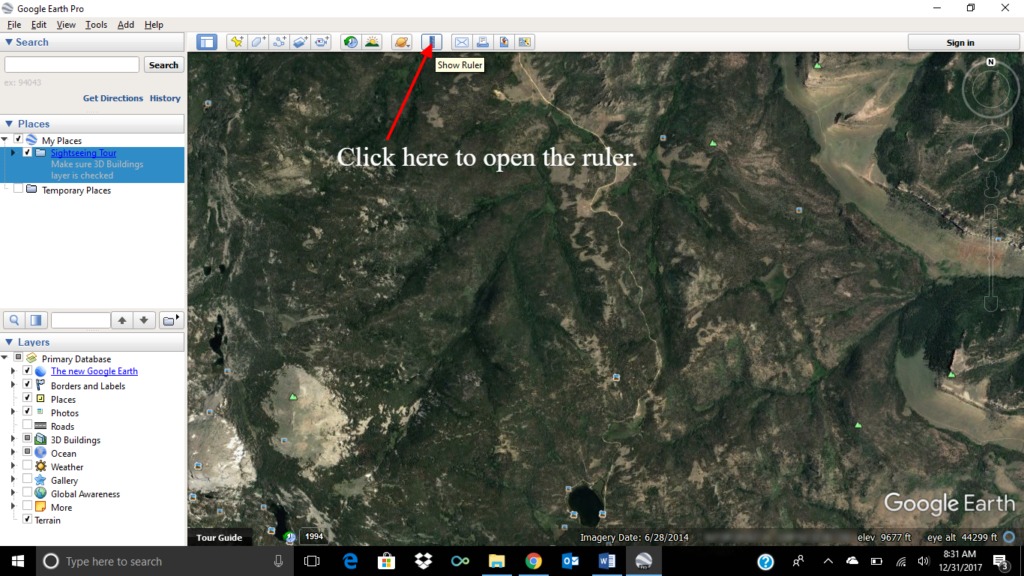

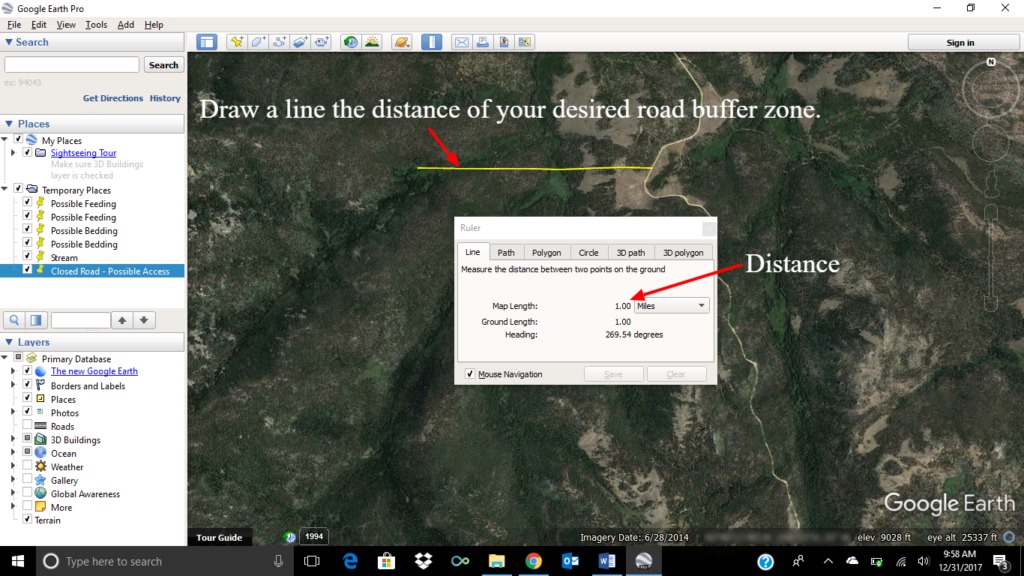
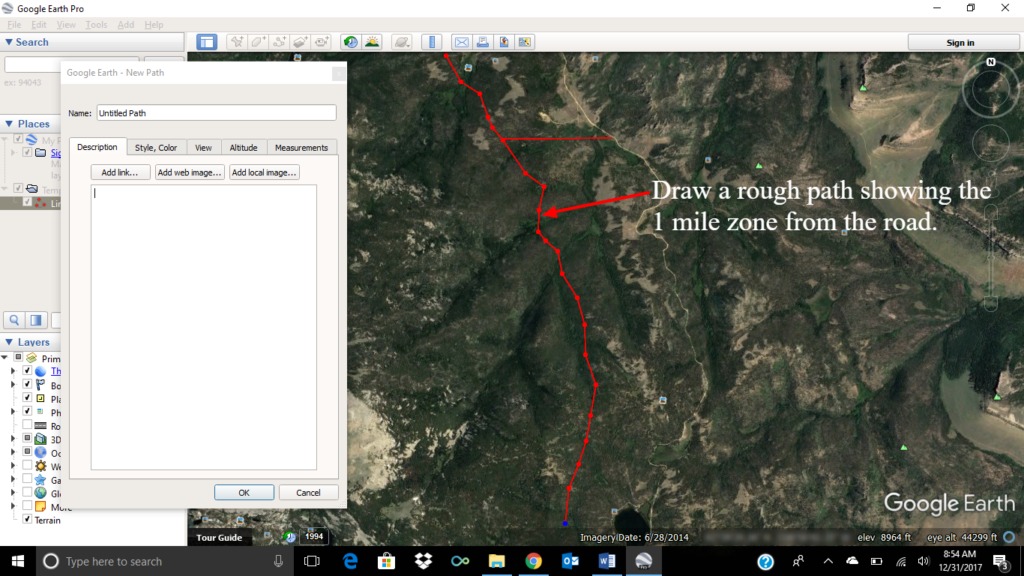

Finding Water Sources
Water is essential for elk since they need to drink water on a daily basis. Use this basic fact to your advantage by searching for and marking water sources on the map.
- Water holes and creeks are great starting points.
- If the water holes or creeks are not obvious, you simply need to look for an area that is greener and lusher than the surrounding areas.
- It is important to try to find as many of these locations as you can because elk are very cautious and don’t like to use the same water hole every day.
- Another reason to find the green, wet areas are wallows.
- When you are hunting on hot days and are not having any other luck hunting elk, wallows are a good alternative to wandering around aimlessly.
- Elk will come to their wallows on these hot days to cool off during mid-day.
- You can take advantage of this by finding a location that overlooks this wallow or on a trail that leads to the wallow and waiting for the elk to come to you.
Finding Food Sources
Food is the next element on your list. Understanding the eating habits of elk is important to find the right spots. This is because elk eat primarily during the early morning and late evening hours. Once you have these areas located you will be able to set up at a glassing location and glass these feeding areas. This will be your best chance of finding elk during most times of the year.
- Unlike mule deer, elk are primarily grazers and they need about 20 pounds of food a day.
- You will often find elk grazing in openings and burn areas feeding on native grasses, which are their primary food source, most times.
- Grassy areas are usually easy to find, especially in areas that are heavily timbered on the satellite imagery.
- Elk will favor large meadows that can typically be found on south-facing slopes.
- Once the hunting pressure starts, elk may start eating shrubs and forbs in dense areas.
- Don’t get discouraged if you can’t pinpoint these dense feeding areas on Google Earth. They’re not as easy to identify and are one of those things that sometimes can only be found with boots on the ground.
Finding Bedding Areas While E-Scouting for Elk
When hunting elk, remember that elk retreat to cover areas during midday to bed. Many times it is also where a startled herd would flee to, so identifying them is just as important as locating water sources.
- To locate bedding areas you want to look for areas with heavy cover on north and east facing slopes of the mountains.
- Steep slopes and ridges make these timbered areas even better.
- If you are able to find a very steep area with a bench in one of these areas, you have likely hit the jackpot.
- Just remember that you don’t want to enter bedding areas unless there’s a very good reason.
- If you spook an elk out of its bed, it can and probably will run for miles and it may be days or weeks before they return.
- You want to learn these areas though so you will know where the elk will typically go when they are done feeding in the mornings or where they will be coming from in the evening.
- With this information, you will be able to possibly set up for a mid-morning or afternoon ambush while the elk are traveling to or from feeding.
Putting These Elements Together While E-Scouting For Elk
Once you have all your areas covered, mapped out, and marked, it’s time to save all your waypoints and send them to your GPS unit. These are the actual points that will guide you on your first actual boots on the ground trip to the area. They make all the hours you put poring over Google Earth worthwhile. However, if you don’t have a GPS, you can still use those waypoints. Simply print them off Google Earth and take the printed maps with you. You may need to print out more than one map for each area just to have high-quality pictures. Bear in mind that the printed maps don’t have coordinates and won’t be as accurate as GPS. Still having them with you will guide you around and increase your chances of harvesting an elk.
Example: A New Area To Check Out When Done E-Scouting For Elk With Google Earth
When you put all of these elements together you will have one spot ready to check out when hunting season starts. However, you should find several of these areas. If the first spot does not work out during hunting season, you move to the next. Just keep going down your list until you find the elk.
- An Area Showing Ridges Running Roughly East To West

2. After Dropping A Placemark Drag It To The Location You Want It

3. Rename the Placemark

4. Add a Second Feeding Area
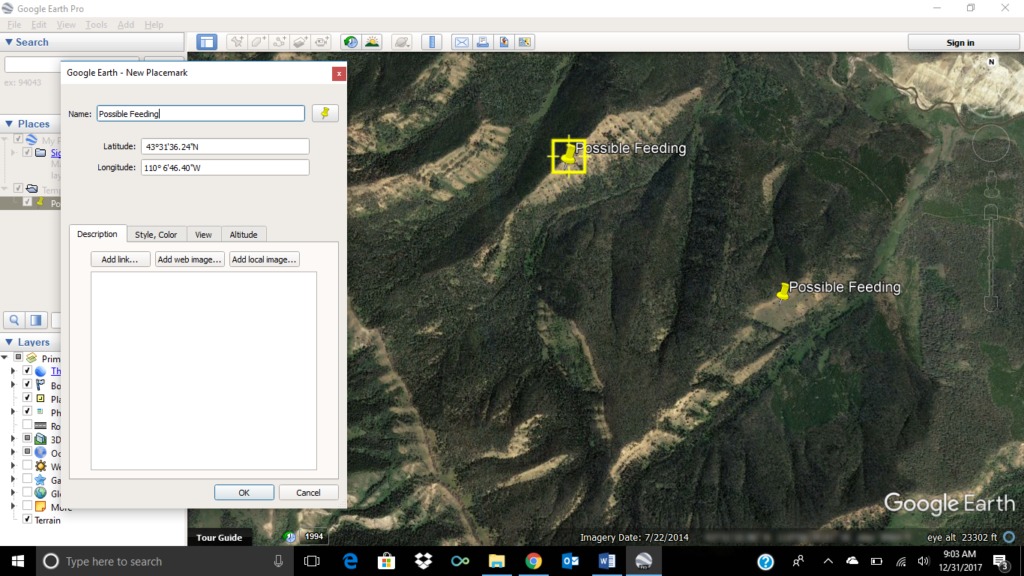
5. Add a Bedding Area
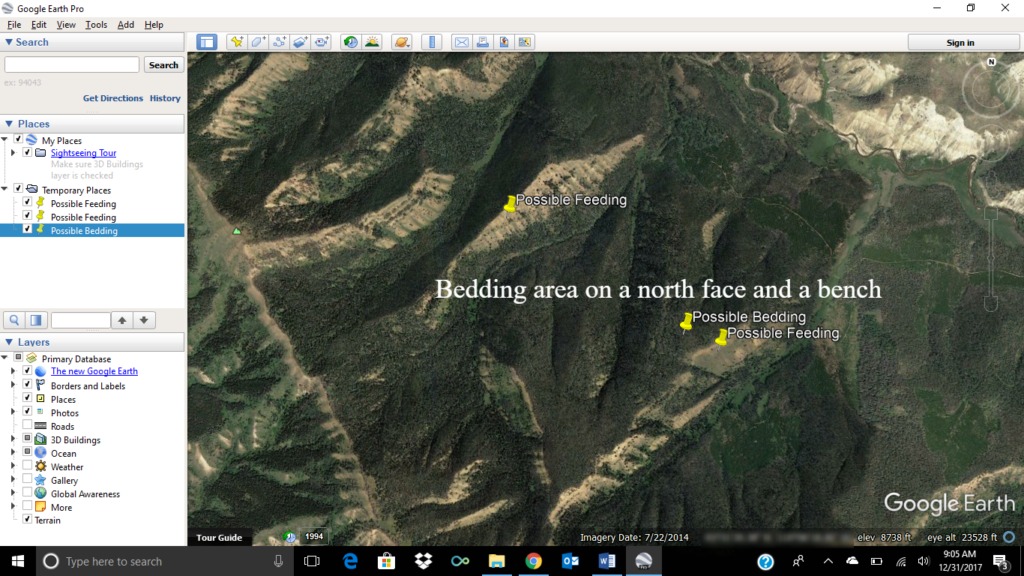
6. After Adding a Placemark Showing The River and a Closed Road That Provides Access , You Have Your First Spot

For more information about scouting for elk on location see our article “Scouting for Elk with Boots on the Ground”.
*Featured Photo by Nicholas Koenig on Unsplash


